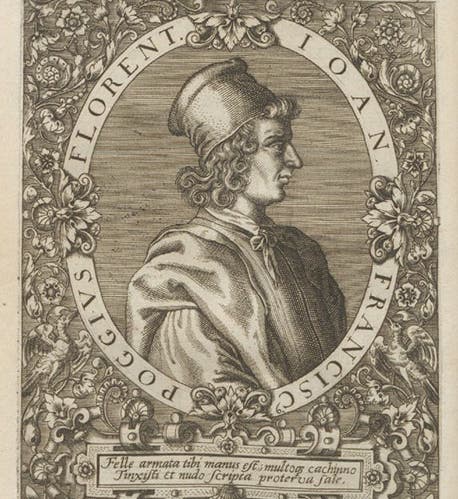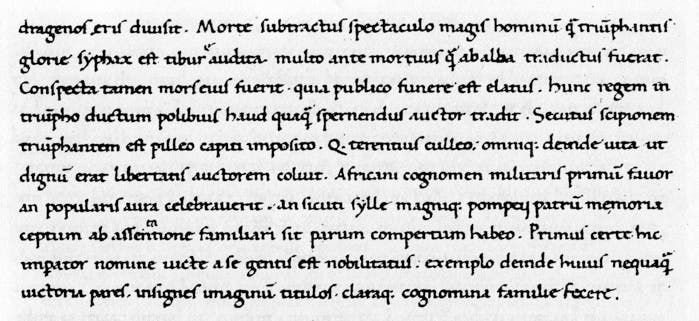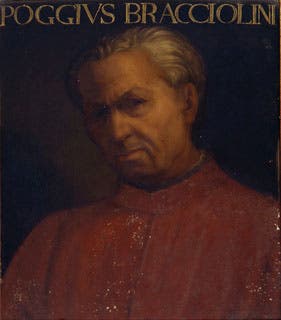Scientist of the Day - Poggio Bracciolini
Poggio Bracciolini, an Italian Renaissance humanist, was born Feb. 11, 1380, in the town of Terranuova, about 20 miles southeast of Florence. Humanists were the people most responsible for discovering the manuscripts of ancient texts and putting the “rebirth” in Renaissance, and Bracciolini was better than most at finding long-lost treasures in monastic libraries. In 1415, he discovered the only surviving manuscript of Vitruvius' Ten Books of Architecture, indeed the only surviving manuscript of any ancient work on Greek and Roman architecture, which became the textual basis for Renaissance architecture. In 1416 or 1417, he discovered in Switzerland a manuscript of an astronomical poem by a Roman writer, Marcus Manilius, who was totally unknown in the West until Bracciolini turned him up. Somewhat later, in 1429, he found a manuscript of Firmicus Maternus’ Mathesis liber, a Roman treatise on astrology. And he found a host of letters, orations, and treatises by the likes of Cicero and Quintilian that we must pass by here.
Most famously, Bracciolini found a copy of Lucretius' philosophical poem, De rerum natura, in a German monastery in 1417. This is our principal source for ancient atomism, and the copy Bracciolini discovered and copied, and then fortunately had copied again, is still the only complete copy we have (we say fortunately, because the original in the monastery has disappeared, along with the copy Bracciolini made, but the second copy made by Niccolò Niccoli is still extant). Stephen Greenblatt published a book ten years ago on Bracciolini's recovery of Lucretius; the book was called The Swerve: How the World Became Modern (2011), and amazingly, it made the New York times non-fiction best-seller list for some weeks running, so perhaps you own a copy, and maybe now is the time to open it. It is very good on Bracciolini and Renaissance manuscript recovery, but, in my opinion, runs off the rails after that.
Like many humanists, who often worked as secretaries when they weren't running off to rummage around in far-flung monasteries, Bracciolini wrote a beautiful script (second image), and it is often said that his handwriting became the prototype for the Roman font developed by early printers such as Nicholas Jenson and Aldus Manutius. We just happen to have in our Library a printed text by Aldus of the first printing of the Firmicus Maternus manuscript found by Poggio (1499). It also has the Manilius text, but I don’t know if that was printed from the manuscript found by Poggio. Anyway, it is interesting to compare the Roman type devised by Manutius with the handwriting of Bracciolini. WE show here a detail of the first page of the Matheseos liber by Firmicus Maternus (third image). It seems fitting that Aldus printed Bracciolini’s texts in a font adapted from Bracciolini’s hand-written script.
There do not appear to be any contemporary portraits of Bracciolini. There is a posthumous portrait by Antonio Pollaiuolo that is occasionally reproduced, and we include it here as our fourth image, but we do not know where it is. We have a portrait of 1597 in our collection, engraved by Theodore de Bry (first image). There is a statue that purports to represent Bracciolini in the Duomo in Florence, with the head sculpted by Donatello. Perhaps his best memorial lies in his hometown, which renamed itself Terranuova Bracciolini in 1862. Drive from Florence to Arezzo and you will run right by it. There is surely a Bracciolini memorial of some kind in the town that took his name, but I could not find one online.
Dr. William B. Ashworth, Jr., Consultant for the History of Science, Linda Hall Library and Associate Professor emeritus, Department of History, University of Missouri-Kansas City. Comments or corrections are welcome; please direct to ashworthw@umkc.edu.









